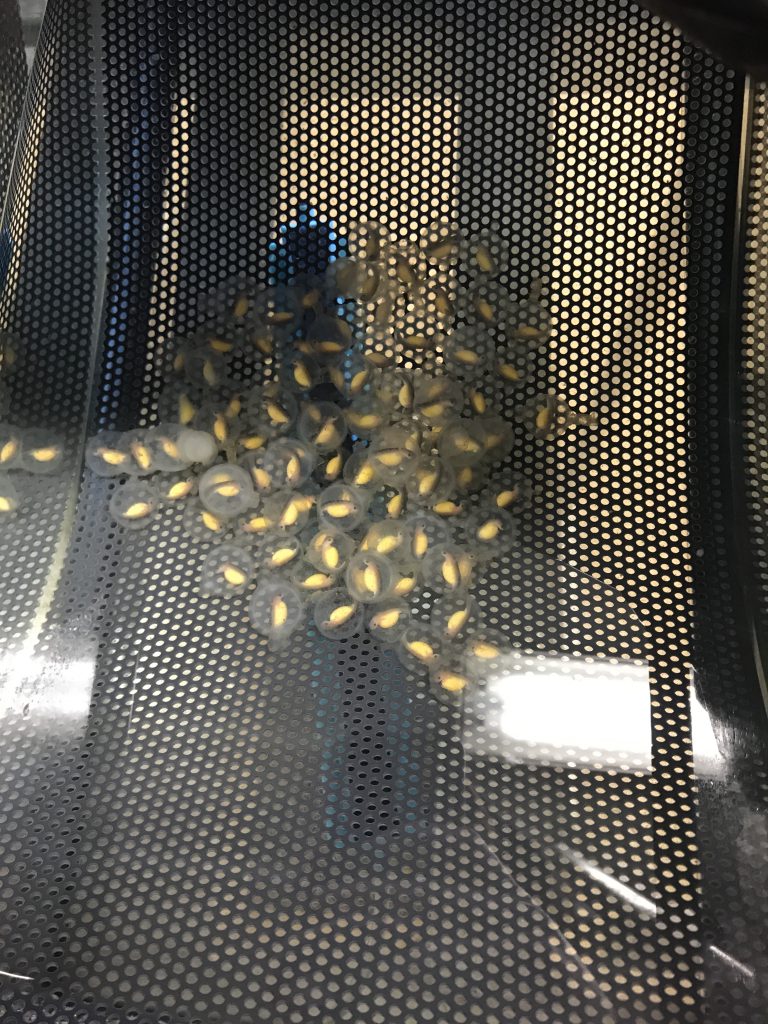
A smile I simply cannot resist! Hellbenders are North America’s largest salamander. They can grow up to approximately two feet in length (twenty-nine inches). Nicknames include:
- Snot otter
- lasagna lizard
- mud devil
- devil dog
- ground puppy
- (Do you have another one?)
These impressive creatures have been around for more than 150 million years, but are in danger. On this week’s virtual field trip, biologists at the Wilds will give us a tour of their hellbender recovery project.
CHOOSE AN ACTIVITY TO LEARN ABOUT HELLBENDERS:
On your own, inside: Read about hellbenders below. Then make lasagna to honor lasagna lizards!
On your own, outside: take a stream selfie and clean up litter.
Hellbenders at the Wilds: Virtual Field Trip
Friday, October 23, 10:30am
Every Friday from 10:30 to 11:00am, we hold a Zoom call live from the woods. This week, the conservation biologists at the Wilds will give us a tour of their hellbender salamander lab!
They’ll show us baby and adult hellbenders. They’ll share how the Wilds is helping the hellbender population grow–and how you can help this endangered species too! You’ll also learn about what it’s like to be a conservation biologist.
The Wilds is a safari-style ‘zoo’ in Cumberland
, Ohio. They have turned damaged, strip-mined land into a center for threatened animal recovery.If you missed it, here is the recording:
Where Hellbenders Live
Hellbenders are a fully aquatic species of salamander! Clean, fast-moving river water is an ideal habitat. The water must be cool, so shady trees help. Look for large rocks with accessible crevices and places where this salamander can hide.
They are very sensitive to pollution and sediment (bits of dirt and dust) in the water. That is why it is so rare to see one. But we keep hoping we will one day!

WHAT IT LOOKS LIKE
They have a flat head, wrinkly body, and paddle-shaped tail. Usually these salamanders are dark grey or brown in color with dark spots along the back.
They breathe through their skin! So the wrinklier their skin is, the more oxygen they get from the water.
WHAT IT EATS
These salamanders feast on crawdads, smalls fish, snails, and worms. Hellbenders are also known to be cannibalistic. That means a bigger salamander may see a smaller salamander as an opportunistic meal! Gulp!
WHERE IT LIVES
Rivers in the eastern United States, including the Appalachian region.

What’s your favorite nickname for the hellbender? I personally love snot otter. Post your answer in the comments and tell us why!
On your own: Make Lasagna!
In honor of their nickname, lasagna lizards, bake some lasagna for your next meal! This activity may require adult supervision. Benders have flaps of skin on their sides, which provide extra surface area to help them breathe through their skin, but it also kind of makes them look like lasagna, which is where the nickname comes from.

Own your own: Snap a selfie!
More cheese, please! Cheese, as in smile, that is! Participate in Stream Selfie. This is a citizen science project that was designed to help monitor waterways (and healthy waterways are crucial for hellbenders).
Take a picture of yourself in or by a waterway, tell us your location and the condition of the stream. Some things to pay attention to might be:
- How big is the waterway?
- Is the water clean?
- Are there fish living in there?
- What other species of animals do you see?
- learn more about using insects/fish to tell if a stream is healthy in this post.
- What might make this good or bad habitat for a species like a hellbender?
- see the where hellbenders live above.
Post your selfie in the comments!

While you’re there, take some time to pick up any litter around the stream. Hellbenders and other species are very sensitive to pollution. By keeping the creek clean
, you help the animals that live there.

3 replies on “Saving Hellbenders with the Wilds: Virtual Field Trip, Oct. 23rd”
Probably not a good idea to explain where to find an endangered, sought after species in a conservation post. 😉
Thanks for that note! I changed that section’s title to “Where Hellbenders Live” to better reflect our intention, which was to teach about quality habitat. Do you suggest any other changes?
Kellen (age 7) and Greyson (age 5) are on a hellbender hunt on our farm in Logan, Ohio. They say if they ever see a hellbender they would call it The Big Boog.